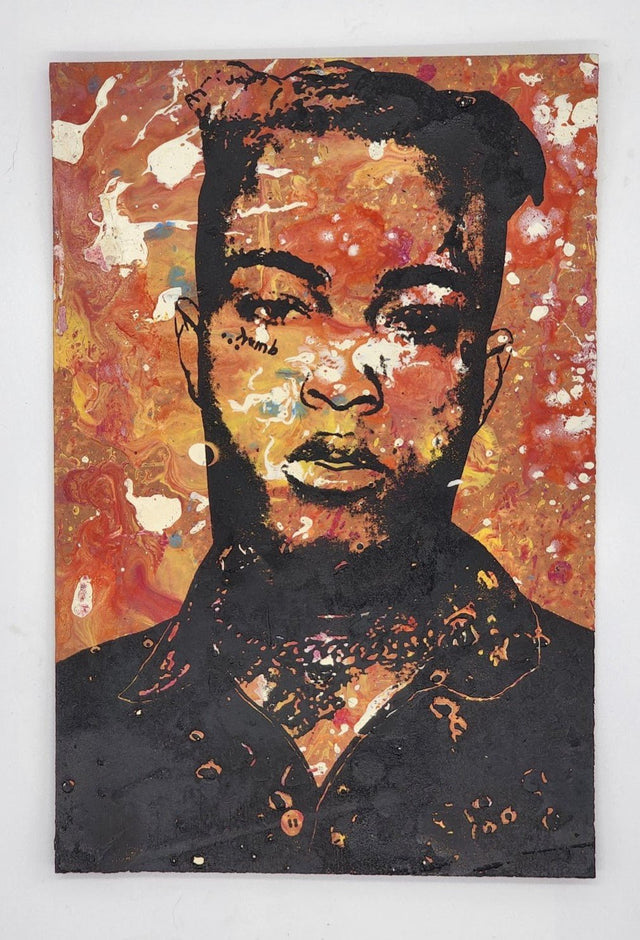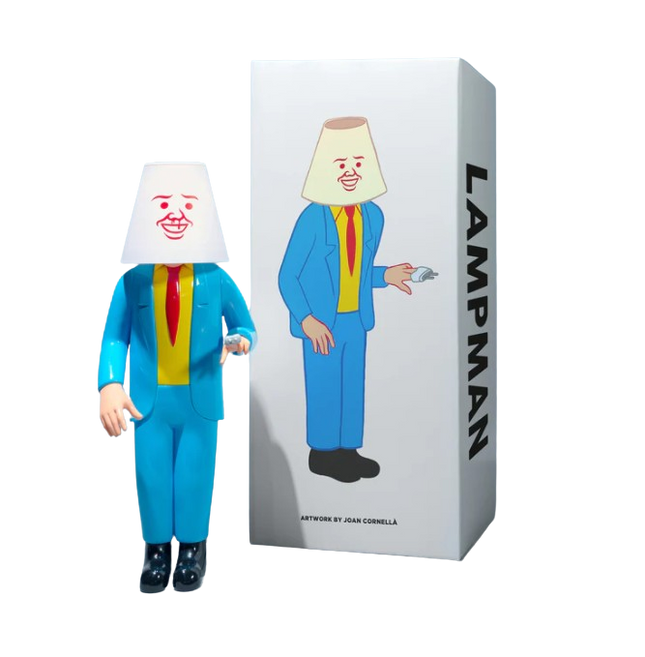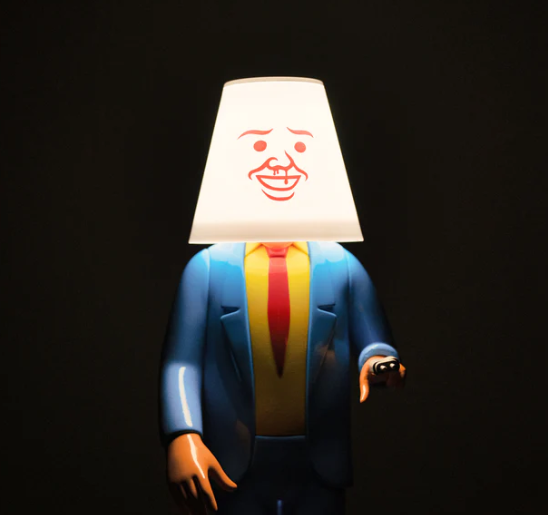
Man Male


Joan Cornellà Lampman Lamp Vinyl Mixed Media Art Object by Joan Cornellà
Lampman Lamp Vinyl Mixed Media Art Object by Joan Cornellà Limited Edition Collectible Sculpture Figure Fine Artwork by Graffiti Pop Street Artist. 2024 Limited Edition of 300 Artwork Size 5x9.8 New In Box Printed Foot Vinyl Fine Art Object Lamp Figure Sculpture. Man in Blue Suit with Lamp Shade Head & Electric Pronged Finger Real Working Lamp Art Object Light. The Luminous Satire of Joan Cornellà's Lampman The "Lampman" lamp vinyl mixed media art object is another inventive creation by Joan Cornellà, a limited edition collectible sculpture that doubles as a functional lamp. Released in a limited edition of 300 in 2024, the artwork features a man in a blue suit with a lampshade for a head and an electric prong for a finger – a surreal depiction typical of Cornellà's unique aesthetic in street pop art and graffiti artwork. As with his other works, the "Lampman" is a playful object and a commentary piece, encapsulating the artist's dark humor and critique of contemporary society. Joan Cornellà's Exploration of Form and Function in Art Cornellà's "Lampman" challenges the distinction between art object and utility, a direction that contemporary artists have increasingly explored. While serving as a light source, this piece illuminates the artist's perspective on human-automation and our relationship with technology. The man's lampshade head can be seen as a metaphor for enlightenment, or perhaps the lack thereof, in our modern age. At the same time, his finger, shaped like an electrical prong, suggests a direct yet absurd connection to the power we harness and rely upon. Cornellà's artwork, stamped with his printed signature on the foot, continues his tradition of blending fine art with everyday objects, creating thought-provoking and functional pieces. Cornellà's Impact on the World of Collectible Art Joan Cornellà's work, particularly pieces like the "Lampman," has significantly contributed to the world of collectible art, especially within street pop art and graffiti artwork. The limited edition nature of such pieces creates a sense of exclusivity and urgency among collectors and art lovers, further blurring the lines between high art and commercial commodities. Cornellà's ability to inject his signature brand of satirical commentary into functional objects like lamps expands the canvas of street art beyond walls and galleries, inviting art into the personal spaces of everyday life. In crafting "Lampman," Cornellà invites us to reconsider the role of art in our lives—not merely as passive observers but as active participants engaging with the art physically and functionally. This delicate vinyl art object is a shining example of Cornellà's ingenuity and influence on contemporary art culture, demonstrating that art can be as practical as it is expressive. User
$1,354.99


Joan Cornellà Lampman Lamp Light Sculpture Object Art by Joan Cornellà
Lampman Lamp Light Sculpture Object Art by Joan Cornellà Limited Edition Designer Collectible Pop Artist Artwork. 2024 Limited Edition of 300 Rare Battery Powered Lamp Sculpture Art Object Size 6x9.8 Artwork. Exploring the Intriguing World of Pop Art Objects The realm of Pop Art has always been one of intrigue and fascination, with objects that often blur the lines between artistic expression and everyday utility. One such captivating piece is the 'Lampman' lamp light sculpture, an art object conceived by the renowned Spanish artist Joan Cornellà. His limited edition designer collectible combines the functionality of a lamp with the aesthetic pleasure of a sculpture, creating a piece that is both practical and whimsically surreal. Joan Cornellà's Unique Brand of Satirical Artistry Joan Cornellà's work is known for its brightly colored, often unsettling representation of contemporary social interaction, rendered in his unmistakably crisp and cheerful style. The 'Lampman' piece continues this thematic exploration, encapsulating modern existence's absurdity and bizarre nature. Released in 2024, this rare art object is a limited edition release, with only 300 units crafted, making it a sought-after item for collectors and admirers of Cornellà's work. Sized at 6x9.8 inches, it is a compact, battery-powered lamp sculpture designed to fit into various spaces, from the intimacy of a personal study to the more public domain of a gallery. The 'Lampman' is not just a lamp; it is a statement, a piece that challenges the viewer to reconsider the boundaries between art and design, form and function, fun and critique. Through this work, Cornellà continues to push the boundaries of Street Pop Art & Graffiti Artwork, exploring how these forms can extend beyond traditional canvases and walls into three-dimensional objects that inhabit our daily spaces. The 'Lampman': A Fusion of Art and Everyday Life The 'Lampman' lamp sculpture represents Joan Cornellà's acute ability to transform the mundane into the extraordinary. Its bold colors and design echo the sentiment of Street Pop Art & Graffiti Artwork, where everyday items become the substrates for creative expression. The lamp, characterized by its distinctive figure with a lampshade for a head, sporting a content smile, invites reflection on the interplay between the light it emits and its shaded expression. This piece symbolizes a movement where art is not confined to the walls of galleries or the exterior of buildings but is integrated into the objects we use daily. Cornellà's 'Lampman' serves as a bridge, inviting art into the living spaces of individuals, allowing for an intimate and constant engagement with creativity. The playful yet provocative nature of the piece encapsulates the core of what Pop Art strives to achieve. This art form is accessible, relatable, and deeply rooted in the fabric of contemporary culture. The Collectible Nature of Cornellà's Creations The collectible nature of Joan Cornellà's 'Lampman' lamp sculpture speaks to the intersection of art commerce and the personal gratification of owning a piece of art that serves a functional purpose. The limited edition aspect of these 300 pieces creates an air of exclusivity and desirability among art collectors and enthusiasts. As a contemporary artist, Cornellà keenly understands the importance of making art that resonates on multiple levels - as an object of aesthetic pleasure, a functional item, and a valuable collectible. In making the 'Lampman,' Cornellà has once again demonstrated his expertise in crafting art that crosses the threshold from the artist's imagination into tangible reality. The lamp light sculpture is not merely an object to be looked at but to be experienced, its light serving as a metaphor for the illumination that art brings into our lives. As an active and influential figure in the art world, Joan Cornellà continues to explore and expand the possibilities of Street Pop Art & Graffiti Artwork, creating pieces that are at once familiar and provocative, practical, and exceptional.
$734.99





